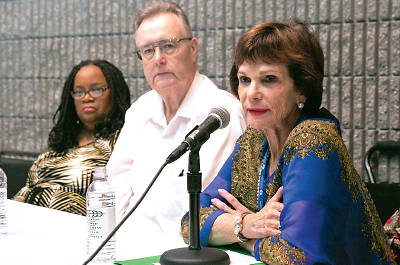Clinician scientists and patients came together at APA’s 2016 Annual Meeting in Atlanta to discuss the effectiveness of electroconvulsive therapy (ECT) and the need for greater access to ECT in Veterans Health Administration (VHA) facilities.
“We are underutilizing ECT—the most effective therapy for depression—in the United States and especially in our VA hospitals,” said session chair Peter Hauser, M.D., a clinical professor of psychiatry at the University of California, Irvine.
As of October 2015, Houser told the audience, 140 of the VHA’s facilities—approximately 49 percent—offer ECT to patients, on both an inpatient and outpatient basis. He noted that a 2014 study by the Department of Veterans Affairs observed that veterans with major depressive disorder and comorbid posttraumatic stress disorder (PTSD) who received an average of 6.5 ECT treatments were almost twice as likely to be alive in the eight years following treatment than their counterparts with the same diagnostic profile who did not receive ECT.
“Studies such as this and others,” said Houser, “provide evidence that we really need to devote more effort in enhancing the use of ECT for our veterans who are at high risk for suicide and who are really seeking rapid relief from depressive symptoms.”
“ECT became an option for me 21 years ago,” said the session’s special guest, Kitty Dukakis, former first lady of Massachusetts and wife of former Democratic presidential nominee Michael Dukakis. Years before treatment, Dukakis suffered from severe symptoms of depression and alcohol use, which she candidly described in her 2006 book Shock: The Healing Power of Electroconvulsive Shock Therapy. “After ECT therapy, I felt better. I was able to live life,” she told the audience.
Dukakis was joined on the panel by veterans who also spoke about their experiences with ECT.
“I had been on medication after medication, pill after pill,” said Diana Weathers, a former member of the U.S. Navy who spoke about living with bipolar disorder. Weathers said that she was advised to undergo ECT after she told her physician that she was contemplating suicide. “After receiving ECT once every two to three days for eight weeks, I felt lighter, ... started reading again, ... and started to enjoy life again,” she said.
When asked by audience members about whether her family backed her decision to undergo ECT, Weathers replied that her husband was a supportive advocate. However, not all ECT recipients get such support because of the stigma commonly associated with the treatment.
“My wife was not an advocate; she still is not,” said Jim Bush, a Marine veteran who had served in Vietnam. “She dislikes the short-term and long-term memory loss. However, I don’t know whether my memory loss was due to my mental health condition or ECT.”
According to Richard Weiner, M.D., interim chair of psychiatry and behavioral sciences at Duke University, anterograde and retrograde memory loss are common side effects of ECT. “The severity and persistence vary,” he said. Other side effects include confusion, delirium, and pain at the site of electrode stimulation.
“Of course, I had headaches after ECT and pain in my mouth,” said Weathers, “but that all subsided relatively quickly. The progress that I made with ECT was worth the side effects, at least for me.”
The scientific presenters of the session mentioned that although research has shown ECT to be a more rapid and effective therapy than any antidepressant, the therapy is strategically used, in most cases, as a secondary treatment option for major depressive symptoms and other psychiatric conditions such as PTSD.
“Because ECT has such a rapid onset of effectiveness for major depressive disorder and comorbid posttraumatic stress disorder,” said Hauser, “we really need to consider and offer ECT earlier after onset of these conditions, and not just as a last line of treatment.” ■

